Catan: Cities & Knights, formerly The Cities and Knights of Catan, is an expansion to the board game The Settlers of Catan for three to four players. It contains features taken from The Settlers of Catan, with emphasis on city development and the use of knights, which are used as a method of attacking other players as well as helping opponents defend Catan against a common foe. Cities & Knights can also be combined with the Catan: Seafarers expansion or with Catan: Traders & Barbarians scenarios.
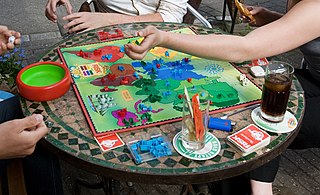
Risk is a strategy board game of diplomacy, conflict and conquest for two to six players. The standard version is played on a board depicting a political map of the world, divided into 42 territories, which are grouped into six continents. Turns rotate among players who control armies of playing pieces with which they attempt to capture territories from other players, with results determined by dice rolls. Players may form and dissolve alliances during the course of the game. The goal of the game is to occupy every territory on the board and, in doing so, eliminate the other players. The game can be lengthy, requiring several hours to multiple days to finish. European versions are structured so that each player has a limited "secret mission" objective that shortens the game.
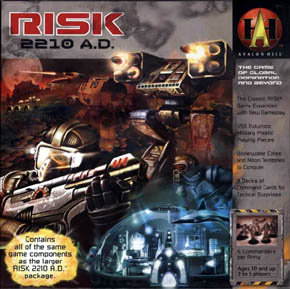
Risk 2210 A.D. is a 2–5 player board game by Avalon Hill that is a futuristic variant of the classic board game Risk. Risk 2210 A.D. was designed by Rob Daviau and Craig Van Ness and first released in 2001. In 2002, it won the Origins Award for "Best Science Fiction or Fantasy Board Game of 2001".

Memoir '44 is a light wargame or war-themed strategy board game for two players. It was created by Richard Borg and published in 2004 by Days of Wonder. Illustration done by Julian Deveil and Cyrrile Dejuan. The game can be played with up to six players if played in teams and up to eight players in the "Overlord" scenarios. However, "Overlord" requires two copies of the game. It received the 2004 International Gamers Award for General Strategy, 2-Player category and The Wargamer 2004 Award for Excellence. The game is published in English and French by Days of Wonder.
Axis & Allies: Pacific is a strategy board game produced by Hasbro under the Avalon Hill name brand. Released on July 31, 2001 and designed by Larry Harris, the designer of the original Axis & Allies game, Axis & Allies: Pacific allows its players to recreate the Pacific Theater of World War II.

Avalon Hill's Advanced Civilization is a computer edition of the Advanced Civilization board game. Both the board and computer game portray the same basic concept: the players manage ancient Mediterranean civilizations in an effort to move them from the early Bronze Age to beyond the Iron Age. It was published in 1995, shortly before Avalon Hill was bought out by Hasbro in 1998.

Risk II is a video game version of the board game Risk, developed by Deep Red Games and published by Hasbro Interactive under the MicroProse label. It's a sequel to the 1996 version of Risk.

Starfarers of Catan is a multiplayer board game loosely based on the Settlers of Catan series of games. It was created by Klaus Teuber as an official spin-off and is distributed by Kosmos in German and Mayfair Games in English.
The Catan Card Game, originally named The Settlers of Catan: The Card Game, is a card-game adaptation of The Settlers of Catan board game. It is a member of the Catan series of games developed by Klaus Teuber and published by Kosmos in German, and by Mayfair Games in English. The Catan Card Game is a two-player game, although the rules can be accommodated as to allow players to share a set or for each player to have their own, as is intended for tournament play. Seven expansions of the Catan Card Game have also been released.
Catan Histories: Struggle for Rome is a 2006 German-style board game based on the game mechanics of Settlers of Catan, depicting the fall of the Western Roman Empire. The game is created by Klaus Teuber, the creator of Settlers, and is published under license from Catan GmbH by Kosmos in German and Mayfair Games in English. It is the second game in the Catan Histories series of board games. Often games produced in different languages by different publishers have slight rule differences between the versions. Catan Histories: Struggle for Rome is no exception.
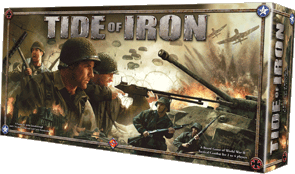
Tide of Iron is a World War II based wargame designed and published in 2007 by Fantasy Flight Games, also notable for publishing other large games containing a large number of counters and/or other components such as World of Warcraft: The Board Game and Arkham Horror.
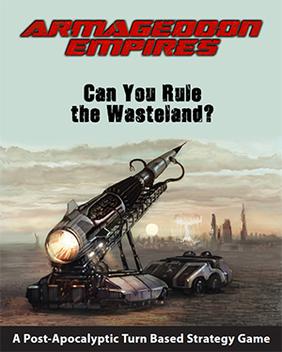
Armageddon Empires is a 4x turn-based strategy video game for Microsoft Windows and Mac OS X. It was released internationally for Microsoft Windows on July 16, 2007, and for Mac OS X on October 9, 2007. The title is the first game released by independent game developer Cryptic Comet.

A board wargame is a wargame with a set playing surface or board, as opposed to being played on a computer or in a more free-form playing area as in miniatures games. The modern, commercial wargaming hobby developed in 1954 following the publication and commercial success of Tactics. The board wargaming hobby continues to enjoy a sizeable following, with a number of game publishers and gaming conventions dedicated to the hobby both in the English-speaking world and further afield.
Catan: Traders & Barbarians is the third expansion to the Settlers of Catan games, developed by Klaus Teuber. It contains a series of new scenarios and small variations, which are meant for two, three, or four players, with limited compatibility between the other two expansions, Catan: Seafarers and Catan: Cities & Knights. Three of the modules had been previously offered as "mini-expansions", though two have new rules in Traders. The expansion itself is named for one of the scenarios therein.
The Rivals for Catan is an updated revision of the Catan Card Game, a card game adaptation of The Settlers of Catan. The game was released in 2010. It is a member of the Catan series of games, and is published by Kosmos in German and Mayfair Games in English. Like its predecessor, The Rivals for Catan is a two-player game. As with the Catan Adventures series of games, the theme is based on the Rebecca Gablé novel The Settlers of Catan, a novel based on the original board game.
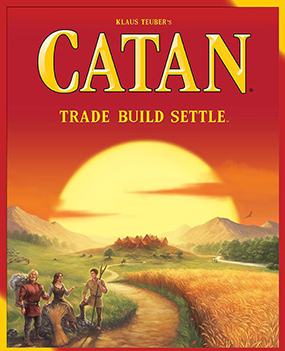
Catan, previously known as The Settlers of Catan or simply Settlers, is a multiplayer board game designed by Klaus Teuber. It was first published in 1995 in Germany by Franckh-Kosmos Verlag (Kosmos) as Die Siedler von Catan. Players take on the roles of settlers, each attempting to build and develop holdings while trading and acquiring resources. Players gain victory points as their settlements grow and the first to reach a set number of victory points, typically 10, wins. The game and its many expansions are also published by Catan Studio, Filosofia, GP, Inc., 999 Games, Κάισσα (Káissa), and Devir. Upon its release, The Settlers of Catan became one of the first Eurogames to achieve popularity outside Europe. As of 2020, more than 32 million copies in 40 languages had been sold.

King of Tokyo is a monster movie-themed tabletop game using custom dice, cards, and boards, designed by Richard Garfield and released in 2011. A New York City-based edition, King of New York, was published in 2014. The game was re-released in 2016, with all-new artwork and characters.

Star Realms is a card-based deck-building science-fiction tabletop game, designed by Rob Dougherty and Darwin Kastle and published in 2014 by Wise Wizard Games. The game started out as a Kickstarter campaign in 2013. The goal of Star Realms is to destroy opponents by purchasing cards using "trade" points and using these cards to attack an opponent's "authority" using "combat" points. The game takes place in a distant future where different races compete to gain resources, trade and outmaneuver each other in a race to become ruler of the galaxy.
Fireside Games is a US based board game publishing company owned and operated by Justin De Witt and Anne-Marie De Witt. Based in Austin, Texas, the company was founded in 2007. They published their first game, Castle Panic in 2009, and have published several expansions and sequels as well as other titles since then.

RisiKo! is an Italian strategy board game based on Risk. Unlike classic versions of Risk, the object of the game is the achievement of a predefined, secret target that is different for each player: the target can be either the conquest of a certain number of territories, of two or more continents, or the annihilation of one opponent.












